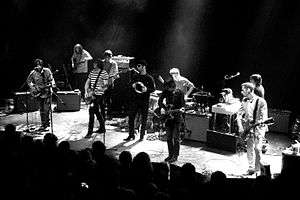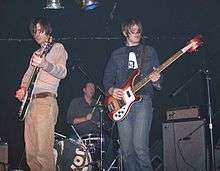The Brian Jonestown Massacre
| The Brian Jonestown Massacre | |
|---|---|
 The Brian Jonestown Massacre performing live at Shepherd's Bush Empire, London, in 2012 | |
| Background information | |
| Origin | San Francisco, California, United States |
| Genres | |
| Years active | 1990–present |
| Labels | |
| Associated acts | |
| Website |
brianjonestownmassacre |
| Members |
|
| Past members | See Former members |
The Brian Jonestown Massacre is an American musical project and band led by Anton Newcombe. It was formed in San Francisco in 1990.
The group was the subject of the 2004 documentary film Dig!, and have gained media notoriety for their tumultuous working relationships as well as the erratic behaviour of Newcombe.[4] The collective has released seventeen albums, five compilation albums, five live albums, thirteen EPs, sixteen singles as well as two various-artist compilation albums to date.
The bandname is a portmanteau of deceased Rolling Stones member Brian Jones and the 1978 Jonestown Massacre[5][6].
Releases
1993–1996: Early years
The collective was founded by Anton Newcombe in San Francisco in between 1990-1993. Their first albums were compilations of multiple recording sessions, and early demo tape, titled Pol Pot's Pleasure Penthouse, became a popular bootleg. Another album, Spacegirl and Other Favorites, was released in 1993 as a vinyl-only release and was compiled from what Anton called his "studio trash".[7] The album includes "Hide and Seek", which was released as a single in 1994. The band's follow-up album, Methodrone, was developed largely out of the concepts explored on 'Spacegirl' and heavily influenced by the shoegaze genre that had gained prominence several years prior to its release. The album's ethereal rock sound is comparable to bands such as Galaxie 500, Spacemen 3 and My Bloody Valentine.[8] Two tracks from the album, "She Made Me" and "Evergreen", were released as a double A-side single in 1992. 'Methodrone' was recorded primarily at a studio in the Hunter's Point region of San Francisco called The Compound, where Naut Humon provided an environment for Anton to record for hours on end.
Over the next couple of years, the band would shift its sound from their more shoegaze, goth, and dream pop influences of the 80's and 90's into a 60's retro-futurist aesthetic. As lineup changes persisted, the band continued to record and in 1996 released three full-length studio albums. The first of these, Their Satanic Majesties' Second Request reflects a pastiche of 1960s psychedelia. The album also includes vast experimentation with a variety of different instrumentation including Indian drones, sitars, Mellotrons, farfisas, didgeridoos, tablas, congas, and glockenspiels.[9] The title of the album is a play on words of the Rolling Stones' 1967 album Their Satanic Majesties Request.[10] Anton has similarly named songs and records this way throughout the band's catalog.
The band's second album released in 1996, Take It from the Man!, is rooted heavily in the maximum rhythm and blues aesthetic of the 1960s British Invasion.[11] The album includes the song "Straight Up and Down", which was later used as theme music for the HBO television drama series Boardwalk Empire (2010–2014), and was engineered by Larry Thrasher of the influential group Psychic TV.
The third and final album released that year was Thank God for Mental Illness, a more stripped-down effort. Since the band did not have a drummer at the time, Anton took the opportunity to showcase more of his acoustic songwriting. The album explores more in-depth genres such as country and folk.[12] At the end of the album Anton included an entire EP called "Sound of Confusion", compiled largely from earlier BJM recordings. "Sound of Confusion" features both regular songs and more abstract sound collages.
1997–1998: Give It Back!, signing to TVT and Strung Out in Heaven
The Brian Jonestown Massacre recorded their sixth album, Give It Back!, in 1997 after relocating to Los Angeles from San Francisco. The album was tracked in a few short days leading up to the band's first US tour, and includes the track "Not If You Were the Last Dandy on Earth", a sardonic reply to The Dandy Warhols' single "Not If You Were the Last Junkie on Earth", which had been perceived at the time as being directed at the BJM. "Not If You Were the Last Dandy on Earth" was featured on the soundtrack to Jim Jarmusch's 2005 film Broken Flowers. During this time, the BJM signed with TVT Records.[12] This led to the release of the band's seventh full-length album, Strung Out in Heaven, in 1998, as well as their first-ever tours of the UK and Japan. Strung Out in Heaven did not sell as many records as TVT had hoped, and as the relationship between themselves and the band deteriorated, they eventually dissolved their remaining contractual obligations with the band.
1999–2005: Bring It All Back Home – Again, Bravery Repetition and Noise, And This Is Our Music and We Are the Radio

In 1999, Which? Records released the EP, Bringing It All Back Home – Again, a collection of songs largely written and recorded around the time the band were working on Give It Back! and Strung Out In Heaven. In 2001, the band released their eighth studio album, Bravery Repetition and Noise. It includes the track "Sailor", a re-work of a song originally performed by The Cryan' Shames.
In 2003, the band released their ninth studio album, And This Is Our Music. "And This Is Our Music" was a step in a new direction for Anton and the group creatively, and emphasized more of the electronic music Anton had explored in the beginning days of the group. The album's title has been called a reference to the identically-titled, but distinct, albums This Is Our Music by the artists Galaxie 500 and Ornette Coleman.
In 2005, the band released the EP We Are the Radio on Newcombe's own label, The Committee to Keep Music Evil, which features a close collaboration with independent singer-songwriter Sarabeth Tucek. This was the last BJM record to be recorded in the United States, as shortly after this Anton relocated to Europe.
2008–2017: Experimental music and recent releases
The Brian Jonestown Massacre released their tenth studio album, My Bloody Underground, in 2008 on Cargo Records. The album is directly inspired by the music made by bands My Bloody Valentine and The Velvet Underground.[13] The record contains a highly experimental approach, and was recorded in collaboration with Mark Gardener, formerly of Ride, who co-wrote the song "Monkey Powder". The Brian Jonestown Massacre recorded both the One EP and Who Killed Sgt. Pepper? in Iceland and Berlin in 2009.
An EP entitled One was released in November 2009 and features the tracks "One", "This Is the First of Your Last Warning" (which also appears on their next album, Who Killed Sgt. Pepper?), an English version of "This Is The First of Your Last Warning", and an exclusive track, "Bruttermania".
Who Killed Sgt. Pepper?, the band's eleventh studio album, was released in February 2010. It features musicians Unnur Andrea Einarsdottir (who recorded vocals on My Bloody Underground), Felix Bondareff from the Russian band Amazing Electronic Talking Cave, as well as the musician Will Carruthers. Soon after the album's release, it was confirmed that Matt Hollywood had returned to the band after an eleven-year absence. According to Anton Newcombe, he would feature on the band's next album and also toured with the band.[12]
The Brian Jonestown Massacre released the album Aufheben on May 1, 2012. Newcombe stated that the album's title relates to Georg Wilhelm Friedrich Hegel's use of the term, whereby something is destroyed in order to preserve it.
Revelation, the band's thirteenth studio album, was released in May 2014. It is the first album to be fully recorded and produced at Anton Newcombe's recording studio in Berlin.[14] Stylistically, the album mixes the traditional Brian Jonestown Massacre sound with Eastern influences.
Their next album, Musique de Film Imaginé, was released on April 27, 2015. The album is conceived as a soundtrack for an imaginary French film, and pays homage to European film directors of the late 1950s and 1960s such as François Truffaut and Jean-Luc Godard. It was recorded in Berlin in August 2014.
In October 2016, the band released the album Third World Pyramid, which was preceded by the single "The Sun Ship".[15][16][17]
Documentary
Along with Portland, Oregon alternative rock band The Dandy Warhols, The Brian Jonestown Massacre were the subjects of the 2004 documentary film Dig!.[18] The film captured a love–hate relationship between both bands, highlighting the interaction of Newcombe with his counterpart in the Warhols, Courtney Taylor-Taylor. The film was recorded over the course of seven years by filmmaker Ondi Timoner, but largely focused on The Brian Jonestown Massacre from late 1996 to mid-1998. Dig! won the Documentary Grand Jury Prize at the 2004 Sundance Film Festival.
Book
A book about the band, Keep Music Evil: The Brian Jonestown Massacre Story will be published on April 16th, 2019, by Jawbone Press. The book was written by actor-filmmaker Jesse Valencia and features interviews with over 120 people connected to the band, including key current and former members, as well as the filmmakers behind Dig!. [19]
Members
Discography
- Studio albums
- Methodrone (1995)
- Spacegirl and Other Favorites (1995)
- Take It from the Man! (1996)
- Their Satanic Majesties' Second Request (1996)
- Thank God for Mental Illness (1996)
- Give It Back! (1997)
- Strung Out in Heaven (1998)
- Bravery Repetition and Noise (2001)
- ...And This Is Our Music (2003)
- My Bloody Underground (2008)
- Who Killed Sgt. Pepper? (2010)
- Aufheben (2012)
- Revelation (2014)
- Musique de Film Imaginé (2015)
- Mini Album Thingy Wingy (2015)
- Third World Pyramid (2016)
- Don't Get Lost (2017)
- Something Else (2018)
References
- ↑ Winter, Greg (October 13, 2003). "Brian Jonestown Massacre - And This Is Our Music". CMJ. New York City: CMJ. Retrieved July 21, 2016.
- 1 2 Stiernberg, Bonnie. "The 50 Best Garage Rock Songs of All Time". Paste. Retrieved July 21, 2016.
- ↑ "Interview: The Brian Jonestown Massacre". Under the Radar. November 2, 2015. Retrieved June 9, 2016.
- ↑ Nashawaty, Chris (May 23, 2005). "Neo-Psych Out". Entertainment Weekly.
- ↑ Hopper, Kevin (January 2, 2004). "A timeless sound keeps psych-rockers BJM relevant". Albuquerque Journal. p. 15.
- ↑ Krause, Charles A (November 19, 2008). "Town Without Pity; 30 Years Later, Memories of Jonestown Evoke Guilt, Anger and Mistrust". The Washington Post. p. C.1.
- ↑ "The Brian Jonestown Massacre - Spacegirl and Other Favorites". LastFM. Retrieved July 5, 2017.
- ↑ Raggett, Ned. "Methodrone – The Brian Jonestown Massacre | Songs, Reviews, Credits | AllMusic". AllMusic. Retrieved June 9, 2016.
- ↑ Ankeny, Jason (1996-06-18). "Their Satanic Majesties' Second Request - The Brian Jonestown Massacre". AllMusic. Retrieved 2012-01-12.
- ↑ Ankeny, Jason. "Their Satanic Majesties' Second Request". AllMusic. Retrieved 10 July 2011.
- ↑ Ankeny, Jason. "Take It from the Man!". AllMusic. Retrieved 10 July 2011.
- 1 2 3 Ankeny, Jason. "The Brian Jonestown Massacre | Biography & History | AllMusic". AllMusic. Retrieved June 9, 2016.
- ↑ Lymangrover, Jason. "My Bloody Underground – The Brian Jonestown Massacre | Songs, Reviews, Credits | AllMusic". AllMusic. Retrieved June 9, 2016.
- ↑ "The Brian Jonestown Massacre "Revelation"- Cargo Records UK". cargorecordsdirect.co.uk. Retrieved 2014-05-31.
- ↑ "The Brian Jonestown Massacre announce new album". Crack Magazine. 2016-09-13. Retrieved 2016-12-01.
- ↑ "Brian Jonestown Massacre deliver more of the same, which will keep most folks pretty happy". The Line of Best Fit. Retrieved 2016-12-01.
- ↑ "Album Review: The Brian Jonestown Massacre - Third World Pyramid". DrownedInSound. Retrieved 2016-12-01.
- ↑ "Dig!". The Guardian. Guardian News and Media Limited. 2012. Retrieved 2 December 2012.
- ↑ "Keep Music Evil: The Brian Jonestown Massacre Story". Retrieved 9 October 2018.
External links
| Wikimedia Commons has media related to The Brian Jonestown Massacre. |